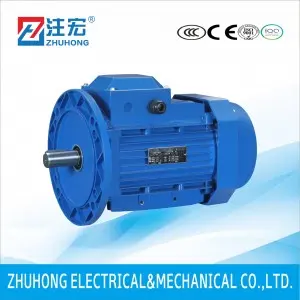After the inspection and processing work before the DC motor is put into operation is completed and the operating conditions are met, the test run can be carried out.
1. Test run of generator
(1) Start
1. Adjust the field rheostat to the breaking device.
2. There is no load on the generator temporarily, and let the prime mover drive the generator to the rated speed.
3. Adjust the magnetic field rheostat to gradually increase the voltage to a certain value.
4. Close the load switch and gradually increase the load, or adjust the magnetic field rheostat to increase the load to the rated value.
5. Adjust the terminal voltage to the rated value.
(2) Parking
1. Gradually reduce the load on the generator while adjusting the field rheostat to the off position.
2. Turn off the load switch.
3. Stop the prime mover.
2. Test run of electric motor
(1) Starting There are four starting methods for DC motors: direct starting method, armature circuit series resistance starting method, reduced pressure starting method and speed regulation method.
The direct starting method has a large starting current, and the maximum inrush current can reach 15 to 20 times the rated value. Therefore, it has a greater impact on the power grid and the motor itself. It is usually only used for starting currents with a starting current of 6 to 8 times the rated current and a power of no more than 4kW. of DC motor. The armature circuit series resistance starting method consumes a lot of energy during the starting process and is not suitable for large and medium-sized motors that are frequently started. The decompression starting method and speed regulation method have low energy consumption and smooth starting, and are used for various types of DC motors that need to be started frequently.
The starting steps are as follows:
1. Do not put a load on when starting the motor for the first time.
2. If it is a speed-regulating motor, the master potentiometer (i.e. speed controller) should be adjusted to the lowest speed position.
3. Turn on the armature and excitation power supply of the motor, and adjust the main potentiometer to gradually increase the speed of the motor until it reaches the rated speed.
4. After the motor runs normally without load, put the load on again and repeat the above procedure.
(2) Parking
1. If it is a speed-regulated motor, the speed should be reduced to the minimum first.
2. If necessary, remove the load (except series motors).
3. Cut off the armature power supply and then the excitation power supply to restore the starting control device to its original state.
(3) Precautions The following matters should be paid attention to when testing the DC motor:
1. The idling time of the motor should be guaranteed to be no less than one hour. Because the brush can ensure good contact with the commutator through long-term grinding, which is of great benefit to normal operation in the future.
2. During the trial operation of more than one hour, observe whether the indications of the ammeter and voltmeter are normal, and check whether the motor has abnormal vibration, heat, oil leakage, noise, etc. At the same time, observe the sparks under the brush at the rated speed of the motor.
3. After shutting down, the condition and heating of the stator, armature, bearings and other parts should be comprehensively checked.
4. For DC speed-regulated motors, during the test run, the excitation voltage, armature voltage, current and three-phase current of the rectifier bridge must be closely monitored to observe whether there is oscillation, imbalance, etc. If necessary, use an oscilloscope to observe the armature voltage. waveform. If any abnormality is found, the thyristor rectifier device should be adjusted before testing.
Post time: Jan-23-2024








